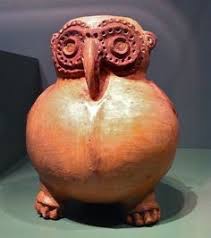The ritual vessel from China and the Central Caribbean tripod vessel in the form of a spectacled owl from Costa Rica both stand upon three legs with two handles. Besides that, these two vessels cannot be more different in their composition and cultural content. The Chinese vessel shows a culture with a developed bronze technique, while the Caribbean vessel shows a culture that focus more on the symbolic value of the object.
The composition of the two vessels is distinctive. The ritual vessel was made by alloy, and it has three legs supporting a round bowl with two handles. The complex process required for making the vessel can demonstrate the proficiency that Chinese metal workers had at that period. Ancient Chinese developed their bronze-age culture without influence from foreign groups, and they created their own method called piece-mold casting, which was totally different than other cultures. In contrast, Bronze Age had never appeared in Central Caribbean culture, so the civils used clay to craft containers with paint for decoration.
Since the two vessels differ from cultural background and time period, the artifacts are significantly diverse. the ritual vessel was made in East Chou Dynasty, between the late Spring and Autumn or the early Warring States period, about 500-450 BC. Known as “ding”, bronze vessels were originally containers for cooking and storing meat in China’s early Bronze Age, but they developed to be used for sacrificial practice in Shang Dynasty (c. 1600 – 1046 BC) and West Chou Dynasty (c. 1046 – 771 BC). As a symbol of power and authority, bronze vessels in giant scale were produced for various ceremonial purposes and events. Taotie (a zoomorphic figure of an ancient evil creature) motif was commonly applied on the outer surface of the vessels. After West Chou, however, as the Kingdom of East Chou (770 – 255 BC) gradually lost its power, bronze vessels were no longer a representation of royalty and nobility, but they were used in daily life of citizens. Correspondingly, the structures and patterns were simplified drastically for mass production. The identity can be found on the ritual vessel, since it has only one type of extremely simple and repetitive pattern around the lid and the body, and the pattern is neither figurative nor abstract.
On the other hand, the Central Caribbean tripod vessel has a different interpretation its artificial content. Even though both vessel had a ritual purpose, the Central Caribbean tripod vessel involves animal presentation, while Chinese doesn’t. It suggests that Caribbean spiritual culture is more related to animals. Constructed to be a container for liquid, the vessel was shaped into a zoomorphic figure, in terms to connect souls and spirits with real world. The vessel has a heritage from Central Caribbean culture, where ancestral societies utilized their creations as mediums to demonstrate their spiritual belief or express their sacred ideas. The vessel was created between 500 to 800 AD. During this period, objects associated with animals were engaged with political and ceremonial rank, similar to the bronze vessels in China’s Bronze Age. The Central Caribbean tripod vessel was elaborated with its zoomorphic figure. The ceramic was shaped as a spectacled owl, a large tropical owl native to Central Caribbean. Spectacled owls were especially related tightly with spiritual mythology in American Indian culture, and among the different tribes, there were many diverse beliefs regarding to spectacled owls. Some groups held the belief that the owls represent death or disease, whereas others saw the owls as a protective spirit or a guardian. However, since there is few information about the artist, the specific meaning of the owl figure is therefore undefined.
To sum up, the ritual vessel and the Central Caribbean tripod vessel manifestly vary in their cultural artifacts, including background and making process. However, they do share a few similarities in their basic structures and functions on ritual activities.

